

Edinburgh-Royal Mile Mercat Cross. The Mercat Cross was the central meeting place where Royal proclamations and other official announcements were read.

It served as a landmark for the merchants and citizens within the official hub of the city market. There is still part of the original 14th century cross built into the shaft of the existing 1885 Mercat Cross which stands to this day. High Street Royal Mile, Edinburgh. Best of Edinburgh *Royal Mile. Best of Edinburgh Attractions David Hume (Philosopher) David Hume statue As we move down into the High Street, you will see the statue of one of the world's greatest philosophers, Edinburgh resident, David Hume (1711 to 1776).

This is located outside the High Court building. Hume was a Scottish empiricist philosopher, economist and historian whose sceptic philosophy restricted human knowledge to that which can be perceived by the senses. Best of Edinburgh *Royal Mile. Best of Edinburgh Attractions Canongate Street Sign The Canongate lies towards the bottom of the Royal Mile on the "tail" of the Castle rock.

In ancient times rich hunting was to be found in the area. It is said that, despite being a holy day, King David I was out hunting close to this area when he found himself separated from his companions. Out of the mist a magnificent hart (a male red deer or stag) appeared, frightening his horse and throwing him to the ground.
Now, while Holyrood Abbey lies beyond the Canongate, under the charter granted by King David to its Canons, they were able to exert considerable influence over the affairs of the area. Many years later, as conditions in the Old Town became increasingly unsanitary and congested, wealthier families moved downhill into newer accommodation in the Canongate, which continued to exist as a distinct and separate burgh from the Old Town until 1865 when it was eventually subsumed within Edinburgh. Proceeding down the Canongate Morocco Land. Lawnmarket, David Hume Statue Bank Street; High Street; Statue Of David HumeDetails Details.
Edinburgh-Royal Mile-Satue of Hume. David Hume Statue, Edinburgh. David Hume Statue.
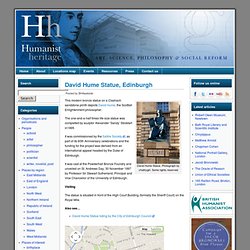
Photograph by chatirygirl. Some rights reserved This modern bronze statue on a Clashach sandstone plinth depicts David Hume, the Scottish Enlightenment philosopher. The one-and-a-half times life size statue was completed by sculptor Alexander ‘Sandy’ Stoddart in1995. David Humes toe. Touch bronze: David Hume's sculpture becomes lucky charm for Scottish students Feb 16, 2007 IHT The superstitious love to touch statues in the hope that luck, brains — or a miracle — will rub off on them.

"Edinburgh Royal Mile ~ Statue of David Hume" by © Sabine A. Rusted ~ The Creative Minds. Featured in Sculpture ~ 158 views CALENDAR LINKThe statue of philosopher David Hume (1711 -1776) was completed in 1995 by sculptor Sandy Stoddart, it is situated in front of the High Court Building (formally the Sheriff Court) on the Royal Mile.
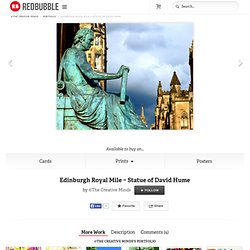
The funding for the project was derived from an international appeal headed by the Duke of Edinburgh. The figure, cast in Bronze, is one-and-a-half times life size and was designed as an ‘extremely grave and serious representation’. David Hume statue, Royal Mile. Alexander Stoddart. Alexander "Sandy" Stoddart (born in Edinburgh , 1959) is a Scottish sculptor, who, since 2008, has been Her Majesty's Sculptor in Ordinary in Scotland . He works primarily on figurative sculpture in clay within the neoclassical tradition .
Stoddart is best known for his civic monuments, including 10 feet (3.0 m) bronze statues of David Hume and Adam Smith, philosophers during the Scottish Enlightenment, on the Royal Mile in Edinburgh, and others of James Clerk Maxwell and John Witherspoon . Stoddart says of his own motivation, "My great ambition is to do sculpture for Scotland", primarily through large civic monuments to figures from the country's past. [ 1 ] He was raised in Renfrewshire where he developed an early interest in the arts and music, and later trained in fine art at the Glasgow School of Art (1976–1980) and read the History of Art at the University of Glasgow. . [ edit ] Biography [ edit ] Early life [ edit ] Education [ edit ] Aesthetic viewpoint [ edit ] Works. EDINBURGH-ROYALMILE.COM - PARLIAMENT SQUARE. Alexander III statue, West door of St. Giles, Edinburgh.
Parliament Square, Statue Of King Charles Ii Details Details. Edinburgh-Royal Mile-Satue of King Charles II Parliament Square. Edinburgh, Parliament Square, Statue of King Charles Ii. Portrait - NPG D32344; Statue of King Charles II in the Parliament Square, Edinburgh. West Parliament Square, Statue Of Fifth Duke Of Buccleuch High Street; Queensberry MemorialDetails Details. Walter Montagu Douglas Scott Royal Mile Edinburgh. Edinburgh-Royal Mile Duke of Buccleuch Statue. File:Buccleuch Statue.jpg. File:Walter Montagu Douglas Scott Royal Mile Edinburgh.jpg. Duke of Buccleuch Statue. Heart of Midlothian (Royal Mile) Coordinates:
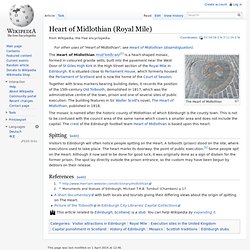
Photo Gallery- RoyalMile-Heart Of Midlothian. James Braidwood statue, Parliament Square. Appointed Master of Fire Engines of Britain's first municipal fire brigade in 1824, the twenty-four-year old Braidwood became a trail-blazer in establishing principles of fire-fighting still applied today.
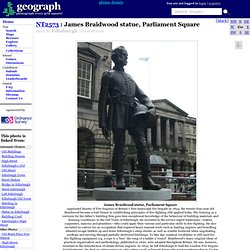
His training as a surveyor for his father's building firm gave him exceptional knowledge of the behaviour of building materials and housing conditions in the Old Town of Edinburgh. He recruited to the service expert tradesmen—slaters, carpenters, masons and plumbers—who could apply their various and particular skills to fire-fighting. He also recruited ex-sailors for an occupation that required heavy manual work such as hauling engines and trundling wheeled escape ladders up and down Edinburgh's steep streets, as well as nimble footwork when negotiating rooftops and moving through partially destroyed buildings. To this day, nautical vocabulary is still used for fire-fighting equipment, e.g. a rope is a 'line', the rung of a ladder a 'round'.
EDINBURGH-ROYALMILE.COM - SATUTE OF JAMES BRAIDWOOD. The James Braidwood Memorial statue, by Glasgow sculptor Kenneth Mackay, in Parliament Square, Edinburgh was unveiled by Professor Sir Timothy O'Shea, Principal of Edinburgh University on the 5th of September 2008.

James Braidwood (1800–1861) was the founder of the world's first municipal fire service in Edinburgh in 1824, and was the first director of what was to become the London Fire Brigade. Born in Edinburgh, Braidwood trained as a cabinet-maker and builder before moving into fire-fighting. James Braidwood Statue. File:Alexander & Bucephalus by John Steell.JPG. Alexander the Great. During his youth, Alexander was tutored by the philosopher Aristotle until the age of 16.
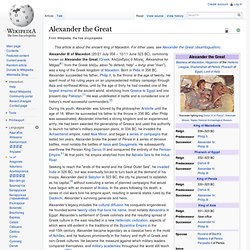
When he succeeded his father to the throne in 336 BC, after Philip was assassinated, Alexander inherited a strong kingdom and an experienced army. He had been awarded the generalship of Greece and used this authority to launch his father's military expansion plans. In 334 BC, he invaded the Achaemenid empire, ruled Asia Minor, and began a series of campaigns that lasted ten years. Bucephalus. The taming of Bucephalus[edit] Alexander taming Bucephalus A statue by John Steell showing Alexander taming Bucephalus The Alexander Romance presents a mythic variant of Bucephalus's origin. In this tale, the colt, whose heroic attributes surpassed even those of Pegasus, is bred and presented to Philip on his own estates.
Edinburgh City Chambers. The former Royal Exchange, Edinburgh. Alexander & Bucephalus by John Steell, located in front of Edinburgh's City Chambers. Modelled 1832, cast in bronze 1883, presented to the city by the subscribers 1884. High Street, Adam Smith Statue Royal Mile; St Giles CathedralDetails Details. The Adam Smith Statue. On the 4th of July 2008, the ASI unveiled the world's first major public monument to Adam Smith – the great Scottish economist, philosopher, and author of The Wealth of Nations. The monument, which takes the form of a 10-foot bronze statue on a massive stone plinth, sits on Edinburgh's Royal Mile – right in the heart of Scotland's capital city, where Adam Smith worked and died. The statue was created by Alexander Stoddart, Scotland's leading monumental sculptor, and was unveiled by Nobel Laureate Economist Professor Vernon L. Smith. The statue's position – in an ancient marketplace – could hardly be more appropriate.
Statue of Adam Smith, beside the Mercat Cross in the Royal Mile. Adam Smith Statue. SATUTE OF DAVID HUME. Sculpted and cast in bronze, by Alexander Stoddart, this imposing statue of Adam Smith, philosopher and father of modern economics thinking, faces down the high street towards his home town of Kircaldy in fife across the river Forth. It was unveiled on 4th July 2008. He was educated in both Glasgow and Oxford, Adam Smith became a freelance lecturer in Edinburgh, (1748), reading literature, economics and philosophy. His success in this led him to take the chair of Logic at Glasgow University in 1751, and in the following year he become professor of moral philosophy. It was here, in 1759, that Smith published his Theory of Moral Sentiment, an antithesis to the human condition of selfishness. This work received with acclaim established his reputation as a philosopher and led to a two year appointment as tutor to the young Duke of Buccleuch and his brother.
This work examined the freedom of economic association - laissez-faire - and its consequences for nations and politics. Overview of Adam Smith Statue. Adam Smith statue, Royal Mile, Edinburgh. Adam Smith Statue, St. Giles' Cathedral, The Royal Mile, Edinburgh. Edinburgh-Royal Mile-Robert Fergusson. Often called Scotland's fogotten poet, it was Robert Fergusson who was the inspiration for to become a poet and he was much admired amongst his contemporary 18th century writers. Born near the Royal Mile, the son of a Aberdeenshire solicitor's clerk, the young Fergusson was priviledged and bright enough to attended St. Andrews Univeristy, although his father's sudden death meant he had to give up his studies before graduating.
He took a mundane job in the Commissary Office as a clerk to help to support his mother and sister. To find an escape from the drugery of copying legal documents he began writing poetry and so began his brief career as a poet. His first poem was published in 1771 and his last was in 1773. Having being known to enjoy a drink or two, he had a fall down a flight of stairs and he received a knock to the head which renderened him insane.
Statue of Robert Fergusson outside Canongate Kirk. John Knox.